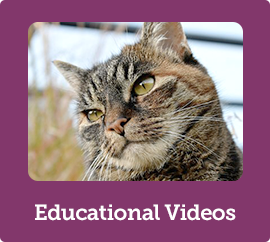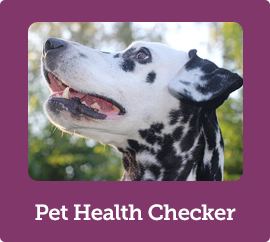Library
-
Proprioception is the ability to know where your body is in space. This is what helps reduce falls and injury. Proprioception may be lost suddenly through spinal cord trauma, or it may be reduced with age, joint disease (osteoarthritis), or other orthopedic or neurologic disease. Some specific controlled exercises that can improve proprioception are discussed. Any exercise plan needs to be formulated by a veterinary rehabilitation therapist to avoid injury.
-
Controlled, regular physical exercise is one of the core treatments of canine osteoarthritis, along with weight control, physical rehabilitation, and pain management. Exercise increases circulation to the muscles and joints, decreases stiffness in the joint capsule and soft tissues, reduces pain, maintains strength, and benefits the cardiovascular system. Left untreated, the chronic pain of arthritis causes a continually worsening cycle of less movement, weight gain, muscle loss, decreased strength, and loss of cardiovascular fitness.
-
Obesity occurs when a cat consumes more calories than they expend. Therefore, managing obesity in cats often requires both dietary changes and increased exercise/activity. There are several methods for increasing activity in cats, including play, using cat trees and climbing structures, outdoor enclosures, and intentional, active feeding practices. Each of these can be beneficial in promoting weight loss.
-
The pancreas is an organ near the stomach and small intestine that produces enzymes needed for digestion, as well as hormones such as insulin that regulate blood sugar levels. Dogs with exocrine pancreatic insufficiency (EPI) are unable to digest nutrients in their diet properly, resulting in maldigestion, weight loss, and abnormal feces than can appear unusually pale and fatty. The disease can be congenital, genetic (such as in German shepherds), or acquired through pancreatic damage. Prognosis is good with treatment, although rarely diabetes is associated with the condition.
-
All glues containing isocyanate and diisocyanate can expand. Pets exposed to a very small amount of wet or liquid expanding glue may consume enough product to be problematic. Foreign body obstruction due to a mass of expanded glue in the stomach is the most common outcome in dogs ingesting expanding wood glues. After abdominal X-rays confirm the presence of a glue mass and obstruction, surgery is required to remove the mass, or endoscopy in mild cases. The prognosis for recovery from expanding glue ingestion depends on the removal of the mass.
-
Extracorporeal shockwave Therapy (ESWT) is a treatment that uses high energy sound waves to exert changes in the target tissues. In specific situations it can decrease pain and increase healing. Conditions that can be treated, types of shockwave therapy, contraindications and adverse effects are discussed.
-
Epiphora or excessive tearing from the eyes can be a sign of tear duct blockage or more serious eye problems. Clinical signs include dampness beneath the eyes, reddish-brown staining of the fur beneath the eyes, odor, skin irritation, and skin infection. The facial anatomy of short faced (brachycephalic) breeds may play a role in this condition. Treatment may include flushing of the nasolacrimal duct, or surgery to open the lacrimal puncta. The prognosis is variable and dependent on whether the underlying cause can be found and treated.
-
Epiphora or excessive tearing from the eyes can be a sign of tear duct blockage or more serious eye problems. Clinical signs include dampness beneath the eyes, reddish-brown staining of the fur beneath the eyes, odor, skin irritation, and skin infection. The facial anatomy of brachycephalic breeds may play a role in this condition. Treatment may include flushing of the nasolacrimal duct, or surgery to open the lacrimal puncta. The prognosis is variable and dependent on whether the underlying cause can be found and treated.
-
Eye melanomas in cats may be benign or malignant (cancerous). Malignant tumors, called diffuse iris melanomas, show up as multiple spots of color change in the iris, while benign tumors, called limbal melanomas, present as a distinct mass at the edge of the cornea. The diagnosis of these tumors is largely by clinical signs and tumor appearance. Treatment for diffuse iris melanomas may include close monitoring, laser surgery, removing part of the iris (iridectomy) and removing the eye (enucleation). Metastasis has been reported in about 19-70% of cases of diffuse iris melanoma, with most spread to the regional lymph nodes, kidneys, liver, and lungs. Treatment for limbal melanomas may include close monitoring, and surgery, sometimes combined with cryosurgery, laser surgery, or radiation therapy. Enucleation is an option if the treatment is unsuccessful, or the tumor regrows.
-
Eye melanomas, although rare, are the most common eye tumor in dogs. These melanomas can originate from the uvea (structures in the front part of the eye) or the limbus (the part where the cornea and the white part of the eye meet). About 80% of uveal melanomas and all limbal melanomas are benign. The rate of metastasis (spread to other parts of the body) is less than 20%. Ocular melanomas are at least in part heritable and may caused by one or more genetic mutations. Uveal melanomas can become discrete, raised pigmented masses that damage the intraocular structures of the eye and cause hyphema (blood in the front part of the eye), uveitis (inflammation of the front part of the eye), and glaucoma (increased pressure in the eye). Limbal melanomas can invade the cornea and cause keratitis (inflamed cornea), grow outwards and cause conjunctivitis, and penetrate and damage the eye as with uveal tumors. Treatment for ocular melanomas may include close monitoring, surgery, iridectomy (removal of part of the iris), laser surgery, cryotherapy, radiation therapy, and enucleation (removing the eye), depending on the type and size of the tumor and how it is affecting the eye. The overall prognosis is good.



